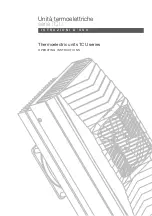
A. INSTALLATION GUIDE 4. INSTALLATION OF THE TANKS
PAGE
16 / 51
Installation and User guide – ECOROCK - Systems – 26-05-2016
4.4 INSTALLATION IN «DIFFICULT» AREAS AND SITES
Conditions of installation:
Difficult ground conditions can be unstable ground, clay, rocks, etc.
If necessary, ensure the adequate drainage of the excavation during installation and anchor the
unit to the concrete slab.
Solutions such as sheet piling should be used to secure the sides of the excavation.
A retaining wall may be necessary to ensure that the backfill does not move in a difficult
installation.
4.4.1 Installation in difficult areas and sites
Never use heavy clay soil for the top soil level. If the top soil to be used is predominantly clay then
mix it with sand.
In all difficult grounds conditions the base of the excavation should be constructed from
concrete with a minimum depth of 300 mm.
Roots and stones can result in damage to the tank wall and should be removed.
The depth to the bottom of the excavation and the concrete base for the Primary Tank must allow
an incline of 2% minimum for the wastewater inlet pipe from the property to the Primary Tank.
4.4.2 Installation in difficult ground conditions
Once the base of the excavation is stable the installation can begin.
Before connecting any pipe work or ventilation pipes ensure the units are perfectly installed and
stable on the excavation base. Ensuring that all levels are correct is crucial if the wastewater is to
flow efficiently through the system.
Pay special attention to the rubber seals. The seals ensure that the system is watertight.
4.4.3 Backfilling in difficult ground conditions
In all difficult ground conditions backfilling should be carried out to a level of 20 cm below the
tank covers. Concrete should be used, compacted and applied in layers of 300 mm.
A retaining wall may be necessary to ensure that the backfill does not move in a difficult
installation. The thickness and structure of any retaining wall should be specified by a qualified
engineer along with the method of construction and backfilling procedure.
At the same time as backfilling around the Primary Tank and BIOROCK® unit both tanks should be
gradually filled with clear water (increments of 300 mm)
Once the backfilling is finished and compacted, check the levels of the tanks again
The various lids or access covers for the system are installed just above ground level to provide
easy access for maintenance.
Position the hatches and secure them with the screws positioned on the sides.
Backfilling to the surface is completed once all pipe work has been connected. With a maximum
depth of 20 cm the backfill should consist of top soil without any stones or sharp objects. When
building up the final level of backfill around the covers keep in mind any future settlement of the
soil.
Содержание ECOROCK-1500
Страница 46: ...C APPENDICES PAGE 46 51 Installation and User guide ECOROCK Systems 26 05 2016 APPENDIX 1 2 1 APPENDIX 2 2 2...
Страница 47: ...C APPENDICES PAGE 47 51 Installation and User guide ECOROCK Systems 26 05 2016 APPENDIX 2 2 3 APPENDIX 2 2 4...
Страница 48: ...C APPENDICES PAGE 48 51 Installation and User guide ECOROCK Systems 26 05 2016 APPENDIX 2 2 5 APPENDIX 2 2 6...
Страница 49: ...C APPENDICES PAGE 49 51 Installation and User guide ECOROCK Systems 26 05 2016 APPENDIX 2 2 7 APPENDIX 2 2 8...
Страница 51: ...C APPENDICES PAGE 51 51 Installation and User guide ECOROCK Systems 26 05 2016...
















































